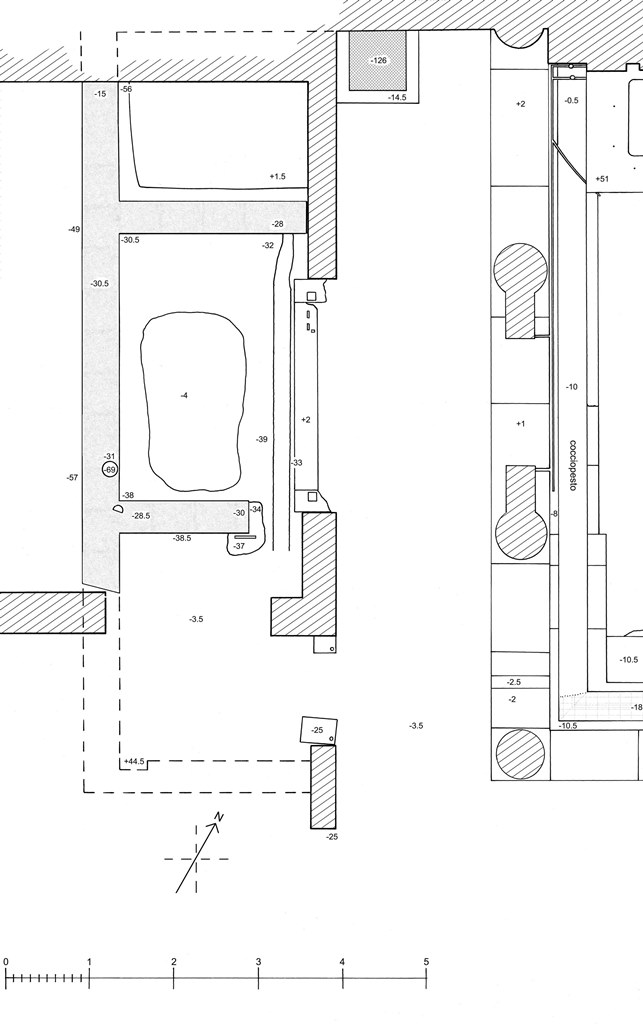Earlier remains
Description
Thomas Staub
Under the latest floor level of the large dining room g, remains of earlier walls and pavements were detected when searching for the floor in this room. These earlier walls (preserved up to a height of 0.05 - 0.15 m) define three smaller, partly interconnected, rooms to the west of the peristyle, about 0.4 m under the floor level of that area. The three rooms were all approx. 2.2 m wide. The southernmost room (g 3) was probably 2.7 m long (the southern part of the boundary wall to the west was totally demolished or is partly hidden beneath the preserved floor in corridor h’), with a narrow doorway (0.65 m wide) to the adjacent room g 2. This room should have had a door directly towards the peristyle as well, but its east wall was totally replaced when corridor h’ and room g were erected. This room probably extended to the north wall of room f. On the northern side of this wall, that is, on the side of room g 3, next to the door opening between room f and the later corridor h’, the upper parts of a niche for a cline are visible above the floor level of the later corridor, filled in during a later reconstruction phase.
Room g 2 was the largest one, with a length of 3.2 m. The cocciopesto pavement is quite well preserved along the walls, still showing in parts the red paint on its surface. In the doorway towards room g 3, the floor has a more pinkish colour and seems to continue into that room. Room g 2 seems to have opened up in at least nearly its total width towards the peristyle. In a narrow strip (0.18 m) shortly to the west of this opening, the pavement is missing: probably a mosaic strip was situated here, which was extracted before the room was filled up. No passage seems to have existed between this room and the next one to the north (room g 1).
Room g 1, the northernmost one, was probably 1.9 m wide, but its exact width could not be determined since the northern wall of room g was later placed on its northern part. No remains of the floor were uncovered since most of this area could not be excavated as some remains of the bedding of the floor of room g are preserved. This room must have been entered through a doorway from the peristyle. In the northernmost part of the west wall of the peristyle, the frames for this door (0.9 m wide) are still visible, partly covered by later plaster.
The lowest parts of the walls partly still preserve remains of the painted decoration. On the outside of the west wall, i.e., the boundary wall of these rooms, the decorations in grey, purple and red form different segments on the wall. These decorations are on the west side of the wall and thus belonged to the neighbouring house. On the south wall of room g 2 some remains of marble imitation sprinkled with red and yellow on a whitish ground adorned the socle. Mainly because of these elements, the decorations might be attributed to the Second Style.
In the west wall, near the southwestern corner of room g 2 two vertical drain pipes of terracotta could be observed. They probably served to carry away rainwater from the roofs. The northernmost of these drains seems to have been made of reused amphorae, since remains of a broken-off handle are visible on one side. The other one is made of semicylindrical half pipes combined with standing pieces of tiles. These drains indicate that the area to the west of these earlier rooms was covered as well, and not an open area. Had that area been open, it would have made more sense to lead the rainwater from the roofs to that space and to a potential cistern.


